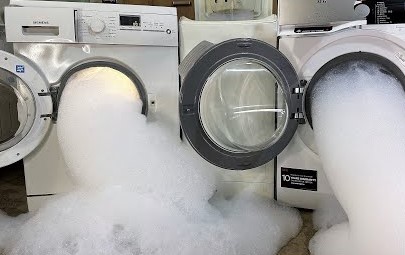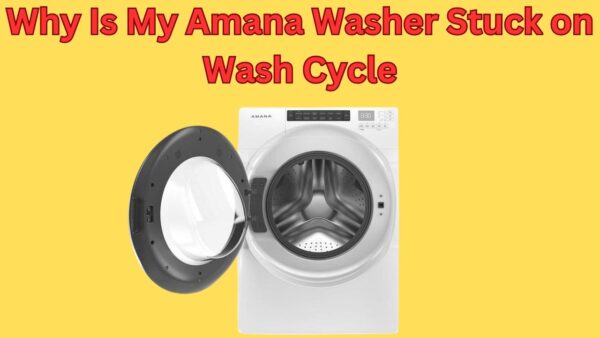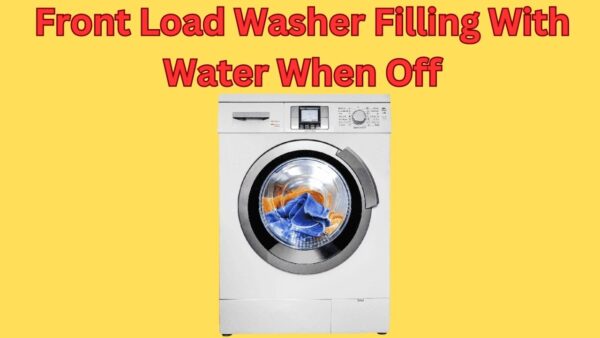Hello, dear guest welcome to our blog. If your Kenmore Washing Machine leaks from the Bottom.
So Don’t worry about this expected problem.
In this guide, we explain 12 common reasons for these problems with amazing fixes.
Kenmore Washing Machine Leaking From the Bottom

1. Faulty Door Seal
Cause
The door seal, also known as the gasket, is a rubber component that keeps water from leaking out during a wash.
If this piece is damaged or worn out, it could be the culprit behind your Kenmore washing machine leaking from the bottom.
The seal can get damaged due to excessive wear or foreign objects like zippers or buttons.
Solution
The best solution is to inspect the door seal. Open the door of your washing machine and check the seal carefully for any signs of damage.
If you spot any cracks, tears, or signs of wear, it’s time to replace it.
Replacing a door seal may sound daunting, but trust me, it’s a doable task with a little patience and the right tools.
Just make sure you buy the right replacement part that fits your Kenmore model.
Remember, a damaged door seal is a common cause of leaks in washing machines.
Regular inspection and timely replacement can save you from bigger problems. So, take this seriously and make it a part of your appliance maintenance routine.

2. Defective Water Inlet Valve
Cause
The water inlet valve controls the flow of water into your washing machine. If this valve is defective or broken, it can cause your Kenmore machine to leak from the bottom.
This may happen due to mineral deposits buildup, or mechanical wear and tear. This valve is a critical component and any malfunction can lead to a water leakage issue.
Solution
The first step is to turn off the water supply and disconnect the hoses. Then, inspect the water inlet valve for any signs of damage or mineral deposits.
If you find it to be defective, it’s time for a replacement. You can order a new one online or from a local appliance parts store.
Replacing a water inlet valve is a simple task if you approach it with patience and the right tools.
Always remember, when dealing with water and electricity, safety should be your top priority. Check your Kenmore washing machine’s manual for specific instructions related to your model.
3. Loose Drain Hose
Cause
The drain hose is like the exit gate for the water in your washing machine.
If this hose is loose, it’s like having an open floodgate, causing water to leak from the bottom of your Kenmore machine.
This can happen due to frequent use, improper installation, or even a little tug that loosens the connection.
Remember, a loose drain hose not only causes leaks but can also lead to more serious issues, like flooding.
Solution
First off, check the connection point of the hose to your washing machine. If it’s loose, tighten it up and make sure it’s secure.
If it still leaks, it’s a good idea to replace the hose altogether. You can find a replacement hose online or at your local appliance parts store.
Now, replacing a drain hose may seem like a big deal, but with a little bit of elbow grease and the right tools, you’ll have it done in no time.
Always double-check the connections after replacing the hose. A secure connection will ensure a leak-free operation.
Remember, a tight drain hose equals a happy washing machine!
4. Cracked Tub
Cause
Picture this: your washing machine’s tub is like the captain of a ship, holding everything together.
If the captain cracks under pressure, we’re talking serious water leakage! In the case of your Kenmore washer, tubs can crack due to overloading, age, or using the incorrect detergent.
Cracks in the tub are not always visible, but they can cause a significant amount of water to leak from the bottom.
Solution
If you’re a bit of a detective, find the model number of your washer and hunt down a replacement tub online or in a local appliance store.
Once you’ve got it, it’s a matter of removing the old tub and installing the new one. This might sound a bit scary, but hey, you’ve got this!
Remember, when replacing the tub, ensure the new one is properly sealed and installed to avoid any future leaks.
If this all sounds a bit much, calling a professional isn’t a bad idea, they’ve got the tools and the knowledge to sort it out in a jiffy. Cracked tub, big problem. New tub, problem solved!
5. Worn Out Tub Seal
Cause
The tub seal is like the secret agent of your washing machine, working in the shadows but playing a crucial role.
If the seal is worn out or broken, it won’t be able to keep the water in the tub, causing your Kenmore machine to leak from the bottom.
Tub seals can wear out over time due to regular use and exposure to harsh detergents. Remember, even the smallest wear in the tub seal can lead to a water leak.
Solution
Don’t let a worn-out seal rain on your laundry day! You can replace it yourself with a bit of determination and the right tools.
First, locate the tub seal (you might need to disassemble some parts of your machine), then inspect it for signs of wear.
If it’s looking a bit worse for wear, it’s time for a change. Make sure to purchase the correct replacement part for your Kenmore model. Install the new seal, ensuring it fits snugly and securely.
A well-fitted new seal means a leak-free laundry time. Remember, if this task seems too daunting or the problem persists, calling a professional is always a smart move.
A worn-out tub seal is a silent culprit, but a swift replacement can save your day!
6. Busted Water Pump
Cause
The water pump is the heart of your Kenmore washing machine’s water circulation system.
If it’s busted, it can’t do its job properly, leading to water leaking from the bottom of your machine.
The pump can go kaput due to wear and tear, a blockage from lint or coins, or even a mechanical failure, turning your laundry routine into a soggy mess.
Remember, a malfunctioning water pump can transform your laundry day into an unwanted pool party.
Solution
Got a busted water pump? Don’t freak out! You can replace it yourself with a bit of grit and the right tools.
First, disconnect the power and remove the machine’s back panel to gain access to the pump. Check the pump for any obvious damage or blockage.
If you spot the culprit, it’s time to replace the pump. Ensure to order the correct replacement for your Kenmore model – a wrong part can lead to more mishaps.
Installation is pretty straightforward – just reconnect everything as it was.
Remember, a well-functioning water pump keeps your machine and your laundry routine running smoothly.
If this all sounds a bit too much, calling a professional is always a good idea. Because, let’s face it, a busted water pump is a bummer, but a quick fix can get you back in the spin cycle in no time!
7. Damaged Overflow Tube
Cause
Think of your washing machine’s overflow tube as the bouncer at a club. Its job is to control the amount of water entering the tub.
If this tube is damaged or blocked, it can’t do its job properly, causing the washing machine to overflow or even leak from the bottom.
Factors such as regular wear and tear, obstructions, and age can damage the overflow tube. Remember, a damaged overflow tube might turn your laundry day into a water park experience!
Solution
Facing a damaged overflow tube? Keep calm and grab your tools! The first step to tackle this issue is to locate and inspect the tube.
If there’s an obstruction, clear it out. If you see cracks or other signs of damage, you’ll need a replacement.
Make sure to get the right part for your Kenmore model. Once you’ve got the new tube, the next step is removing the old tube and installing the new one.
This might seem challenging, but hey, you’re a DIY star! Remember, a properly functioning overflow tube is key to a smooth and dry laundry day.
If this task seems overwhelming, don’t hesitate to call a pro. Don’t let a damaged overflow tube dampen your spirits. With the right fix, you’ll be back to breezy laundry days in a snap!
8. Corroded Water Supply Lines
Cause
Just like your favorite metal band, your Kenmore washing machine’s water supply lines can also rock out to the tune of corrosion. Why?
The water that flows through these lines can be hard on them over time, causing them to corrode.
This corrosion can lead to weak spots in the lines, which might eventually spring a leak at the bottom of your machine.
Remember, corroded water supply lines might seem like a trivial issue, but they can escalate to major leakage troubles.
Solution
Got corroded water supply lines? No biggie. You’re about to become a rock star of the DIY world! First off, you’ll need to locate the water supply lines at the back of your machine.
Once found, inspect them for any signs of corrosion or leakage. If they’re showing signs of wear, it’s time to replace them with new, heavy-duty lines that can resist corrosion for longer.
Remember, replacing corroded water supply lines can keep your wash days smooth and leak-free.
If you’re not comfortable with this task or if the leakage persists, calling a professional is always a good move.
After all, corroded water supply lines don’t have to play a solo on your laundry day – a quick fix can turn the music back on!
9. Excessive Detergent Use
Cause
Your washing machine is not a monster that feeds on detergents.
Excessive detergent use can create too many suds, which might not rinse out properly. As a result, the excess soap foam can overflow, causing the machine to leak from the bottom.
Remember, too much of a good thing can be bad.
In this case, too much detergent can lead to a foamy disaster and an unexpected puddle in your laundry room. Too many suds equals a soapy, leaky mess!
Solution
Dealing with excessive detergent use? It’s a cinch! The solution is simple: just cut back on the detergent.
Use only the recommended amount as per your load size and the detergent manufacturer’s instructions.
Remember, less is more when it comes to detergent use. Your clothes will be just as clean, and your machine won’t overflow.
You might also want to consider using a low-sud detergent if you have a high-efficiency washing machine.
A properly dosed detergent keeps your laundry day bubble-free and dry! If reducing detergent doesn’t solve the problem, you might want to call a pro.
Don’t let excessive detergent use burst your bubble. A quick adjustment can keep your laundry day smooth and your floor dry!
10. Leaky Tub Seal
Cause
Just as a fortress needs a sturdy gate to keep out invaders, your washing machine relies on a durable tub seal to keep water in its place.
However, this seal can wear out over time or get damaged due to overuse or mishandling, causing water to escape and drip from the bottom of your machine.
Remember, a leaky tub seal might lead to unwanted swimming lessons in your laundry room. A damaged or worn-out tub seal could turn your otherwise pleasant laundry day into a damp disaster.
Solution
Got a leaky tub seal? No sweat! Fixing it is a straightforward task. Begin by ordering a replacement seal that’s compatible with your Kenmore model.
Once it arrives, power off your washing machine, remove the tub following the manufacturer’s instructions and replace the old, leaky seal with your new one. Remember, installing a new tub seal can help keep your laundry day wave-free.
If this task feels daunting, don’t hesitate to call in a professional. A leaky tub seal doesn’t have to sink your spirits. With a quick fix, you’ll be sailing back to dry land in no time!
11. Malfunctioned Pressure Switch
Cause
Like a zealous party planner, your Kenmore washing machine’s pressure switch is meant to keep things under control, specifically water levels.
However, if it malfunctions, the water level might get out of hand, causing an overflow which can lead to leaks from the bottom of your machine.
Remember, a malfunctioned pressure switch can throw your laundry routine out of whack. This is one party that can quickly turn from fun to flood!
Solution
Did you get a malfunctioned pressure switch? Take a deep breath, your DIY skills are about to shine again!
First, find the pressure switch on your machine – usually, it’s located inside the control console. Once you locate it, use a multimeter to test it for continuity.
If it is faulty, it will need to be replaced. Make sure to get the right switch for your Kenmore model. Remember, replacing a malfunctioned pressure switch can bring balance back to your wash and prevent future leaks.
If you’re unsure about handling this task, hiring a professional is the safest bet. Don’t let a malfunctioned pressure switch rain on your parade – a swift fix can restore sunny days to your laundry routine!
12. Cracked Outer Tub
Cause
Just like a cracked egg can’t hold its yolk, a cracked outer tub can’t contain its water. But how does a tub crack?
It can occur due to heavy loads, overloading, or simply the passage of time. When the outer tub cracks, water can escape, causing a puddle at the base of your machine.
Remember, a cracked outer tub can turn your laundry day into a water park experience. Don’t underestimate the power of a tiny crack; it can cause a major leak!
Solution
Got a cracked outer tub? Keep calm, and let’s tackle this! First, you’ll need to confirm the crack by visually inspecting the tub.
If discovered, sadly, there’s no quick fix – a replacement tub will be needed. Make sure to purchase one that fits your Kenmore machine model.
Replacing it might be a little tricky, so if you’re not feeling super confident, it’s best to call a professional.
Remember, replacing a cracked outer tub can help keep your laundry days dry and your floor puddle-free. The laundry day must go on, and a cracked outer tub shouldn’t stop it!
Conclusion
Washing machine leaks can turn an ordinary laundry day into a soapy, watery mess.
But, with a solid understanding of the potential issues and their solutions, there’s no need to panic when your Kenmore washing machine decides to shed some water.
Whether it’s a corroded water supply line, excessive detergent use, a leaky tub seal, a malfunctioned pressure switch, or a cracked outer tub, most of these issues are solvable with a bit of DIY spirit and a quick response.
But never forget, calling in a professional is always a viable option.
Remember, every problem has a solution, and with a swift, informed response, your laundry day can be transformed from a watery fiasco back to a smooth, dry routine.
So, roll up your sleeves, face the challenge, and keep the laundry day spirit alive!
FAQs
What causes my Kenmore washer to leak from the bottom?
Your Kenmore washer could be leaking from the bottom due to several issues like excessive detergent use, a leaky tub seal, a malfunctioned pressure switch, or a cracked outer tub.
How do you fix a leaking washing machine?
The solution depends on the cause; it could involve reducing detergent use, replacing a leaky tub seal or a malfunctioned pressure switch, or even replacing a cracked outer tub.
Is it worth fixing a leaking washing machine?
Yes, it’s typically worth fixing a leaking washing machine, as most leaks are caused by issues that can be rectified with simple repairs or replacements.
Kenmore Washing Machine Not Draining
Kenmore Washer Sensing Light Flashing
Kenmore Dryer Keeps Shutting Off
Washing Machine Making Buzzing Noise When Spinning
Kenmore Washing Machine Not Locking
Kenmore Washer Lid Lock Flashing
Kenmore Washing Machine Not Agitating
Kenmore Washing Machine Leaking Water
Indesit Washing Machine All Lights Flashing and Not Draining
Why Is My Washing Machine Smoking and Smells of Burning

Name: Joseph Title: Owner and Founder Website: myappliancegeek.com
Biographical Info:
Joseph, the creative mind and founder behind myappliancegeek.com is a distinguished expert in the field of home appliances and technology.
Education: Joseph holds a prestigious degree in Appliance Engineering from a renowned institution in the United States, [Stanford University], where he gained a profound understanding of appliance design, mechanics, and technology.
Professional Experience: Joseph’s professional journey spans over [18 ] years in the home appliance industry. His extensive experience includes working with industry-leading appliance manufacturers, prominent retailers, and appliance repair services.
Entrepreneurship: In [2000], Joseph founded myappliancegeek.com, a platform dedicated to providing comprehensive information, advice, and solutions for those seeking guidance in the world of appliances.
Passion for Appliances: Joseph’s unwavering passion for home appliances stems from his belief in their pivotal role in improving our quality of life.
Contributions to the Industry: Joseph’s commitment to the home appliance industry is evident through his extensive writing and speaking engagements.
Community Involvement: Joseph is not only an online presence but also an active member of the community, frequently engaging in outreach programs, local workshops, and charitable initiatives.


